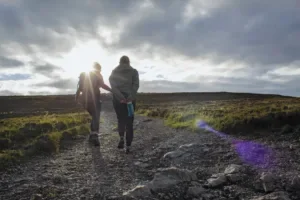AUSTIN, Texas An ancient Maya burial tomb has been unexpectedly uncovered by a University of Texas at Austin team of archeologists participating in a summer field school in the rain forest of northwestern Belize. The group had been researching agriculture and population movements among the Maya and was doing limited excavation work when team members made the discovery.The tomb, located in the ancient city of Dos Hombres, currently is being unearthed, although heavy rains have slowed the progress. According to Dr. Fred Valdez, a UT Austin associate professor of anthropology and director of the Programme for Belize Archeological Project (PfBAP), the tomb dates to the Early Classic (AD 250-600) period.
“We were excavating what we thought was a household structure – small, but elaborately put together,” Valdez said. “When we came across a lot of obsidian or volcanic glass, which typically is spread over something of value to the Maya, we were surprised. We thought maybe it was a special offering of some kind. But a tomb – we were ecstatic.”
The tomb, thus far, contains seven ceramic vessels, including an orange polychrome bowl with a lid cover that has a modeled parrot head as a handle. “One greenstone ear flare (spool shaped ornament) has been revealed with other items being uncovered daily,” said Valdez, adding that the Maya had placed the tomb deep within a room of a rather modest building, filled a space above the tomb, placed a layer of obsidian over the fill, covered the obsidian lens with a plaster floor and painted the floor red before burying the entire structure.Like most archeological excavations, the work is painstakingly slow with team members using paintbrushes and dental tools to unearth the objects. When Valdez realized what they had found, he received emergency funding from the National Geographic Society to extend the dig. The PfBAP has been supported by the National Endowment for the Humanities, the National Science Foundation, the National Geographic Society, UT Austin and private individuals.
“An Early Classic elite royal tomb, like the one UT has discovered, is of great interest to us,” said George Stewart of the National Geographic Society. “Tombs like this can provide great insight into the kind of political transitions that were taking place at the time. Every piece of the mosaic helps.”
The Early Classic period was a time of elaborate ritual, and the discovery will help us better understand this particular time of the Maya, especially burial practices and beliefs,” said Valdez. “Because of the vast amount of obsidian found at the tomb, it is clear that the person buried here was one of great wealth and status. This volcanic glass is traded into the area, making it a valuable commodity.”
Valdez, director of the PfBAP since 1994, said the program focuses on reconstructing ancient Maya society from the bottom up. Great effort has been made to study the everyday lives of the Maya with significant research on ancient land and water management systems, he said.
The PfBAP began at the invitation of Programme for Belize (a land management and conservation organization) which maintains a 239,000-acre research area in northwestern Belize. The organization provides a record of known archeological sites in the region, conducts surveys identifying new sites and determines how to best protect the new finds.
The PfBAP operates under an archeological permit granted by the Department of Archeology in Belmopan, Belize. To date, more than 50 ancient cities, towns and hamlets have been documented.
UT Austin conducts an archeological field school in conjunction with the PfBAP to provide undergraduate and graduate students the opportunity to learn through practical experience. This year, Valdez is joined by 45 students, former students, staff and scholars from other institutions. They will return to the United States in late August.
Though the area is remote, Valdez can communicate with the states using a telephone and fax machine at a small Mennonite grocery store approximately 12 miles from his camp.
The tomb excavation effort is being supervised by Jeff Durst, a doctoral student at UT Austin, as part of his dissertation research. “I suspected these excavations were leading to a very interesting find,” Durst said. “The first clue was the discovery of lots of obsidian, which is a valuable trade item into this area. However, a tomb of this size was unexpected and exciting.”
Mike Stowe, a recent UT Austin graduate and a member of this year’s project in Belize, said he feels lucky to have been at the site when the discovery was made. “This is my first season of excavation in the Maya lowlands and, having read about such discoveries, I consider myself to be one of the fortunate few to work so closely with this type of find. I realize that an excavation of this magnitude is a team effort requiring great patience and a steady hand.”Another tomb was discovered recently at the nearby site of Chan Chich by Dr. Brett Houk, an archeologist at the University of Texas at San Antonio, and a 1996 doctoral student of Valdez’s. Houk had written his dissertation on the site at Dos Hombres under Valdez. The tomb Houk and his team discovered, which already has been unearthed, dates back to a period called the Protoclassic (about AD 150).



